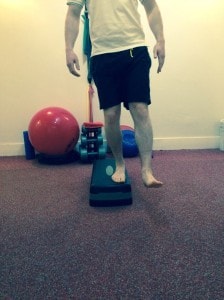Patellofemoral Pain Syndrome, commonly known as “Runner’s Knee”, is a condition which presents primarily as pain at the front of the knee, in the joint formed between the knee-cap (patella) and the underlying bony structures of the knee joint.
While Patellofemoral Pain Syndrome can theoretically present in any individual who undertakes weight bearing exercise, its tendency to commonly present in the running population has led to it being named Runner’s Knee.
How Common Is Runner’s Knee?
Injuries to the leg typically account for up to 80% of running injuries, with knee injuries accounting for the majority of these cases.
Generally, Runner’s Knee has been shown to account for approximately 25% of all knee injuries presenting in sports medicine clinics.
What Causes The Pain Of Runner’s Knee?
The pain associated with Runner’s Knee presents due to an irritation of the joint surfaces created by the patellofemoral joint – the joint formed by the resting of the patella (knee cap) on the thigh (femur). This irritation, due to sub-optimal positioning or tracking of the knee cap, is the result of many of the risk factors found to predispose to Runner’s Knee.
What Are The Risk Factors For Runner’s Knee?
Several risk factors have been identified as predisposing to Runner’s Knee, many of these factors being modifiable. These factors include;
- Weakness of the thigh (quadriceps) muscles
- Tightness of hamstring, hip, & calf muscles
- Poor functionality of the hip muscles
- Over-pronation of the foot (flattening of the arch)
- Poor pliability of the iliotibial (IT) band along the outside of the thigh
- Mal-alignment or hypermobility of the patella (knee cap)
- Over-training
Additionally, several extrinsic factors have also been identified as contributing to the development of Runner’s knee. These factors primarily include an overly acute increase in training distances, and inappropriate footwear.
How Does Runner’s Knee Present?
Runner’s Knee is typically reported as pain or discomfort anywhere around or “behind” the knee cap. These symptoms will often present some time into a prolonged run, with symptoms typically lingering for some time even after running has stopped.
Besides running, typical aggravating activities will include walking downhill or down stairs, deep squatting, or initial movement of the joint having been sat for a prolonged period.
Other, less typically reported symptoms include a pressure at the front of the knee, clicking or snapping at the outer aspect of the knee or hip, a throbbing or ache at the front of the knee, and a perception that the knee may “give way” when weight-bearing.
How Can Physiotherapy Help?
Many physiotherapy treatments have been shown to be successful in their treatment of Runner’s Knee. At K.M. Woods Physiotherapy, treatment is tailored to suit the individual symptom presentation of the patient, following a thorough initial assessment. This individual approach reflects the multi-factorial cause of Runner’s Knee. Treatment may include
- Exercise-based rehabilitation (strengthening, foam rolling, movement control, co-ordination)
- Acupuncture for pain relief and improving tissue state
- Deep tissue release
- Re-Education of lower limb biomechanics
- Advice on training progressions or modification
- Strapping/taping of the implicated knee-cap
What Can I Do To Help This Condition Myself?
Prior to, or while attending physiotherapy, the patient can also help the recovery process by following several steps to address both cause and symptoms of the sore foot
- Tailoring training to only exercise/run as your symptoms allow. With an injury, an increase in painful symptoms is often a sign that the body is not fully conditioned to safely undertake the required task. Exercising within comfortable parameters is generally acceptable, but working outside of these parameters is likely to exacerbate symptoms if it indices an increase in pain etc. Essentially, we seek to reduce the load of exacerbating activities, while we seek to improve conditioning on the implicated tissues, hence making the area more robust and capable of tolerating the training load once it is eventually fully reintroduced.
- Undertaking some cross training and some conditioning work alongside your running will help condition your body in a more balanced manner. Stretching and foam rolling of tight muscles, tendons, & fascia, alongside the strengthening of weakened muscles, will soon address many of the issues addressed above a causative factors.
- Consider recent training parameters – have you recently greatly increased your training volume in a short period of time? If so, returning to a more gradual increase in training may be sufficient to alleviate symptoms.
Wish to enquire if we can he with you hip/knee pain? Or simply looking for advice with regard to training volumes as you look to rehabilitate an injury? Call 0141 3530906 today – our specially trained physiotherapists can help!

